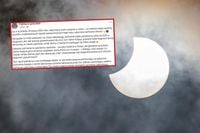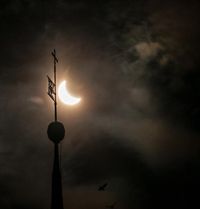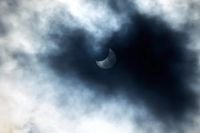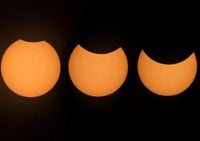On March 29, 2025, a partial solar eclipse will grace the skies over Poland and much of Europe. This celestial event is set to capture the attention of astronomy enthusiasts and casual observers alike, although it won't be as dramatic as a total eclipse. According to forecasts, the maximum coverage of the solar disk will reach approximately 93.61% in northeastern Canada, while in Poland, the obscuration will vary significantly by location.
In cities like Szczecin, observers can expect about 16% of the Sun's surface to be covered by the Moon, whereas in Warsaw, the coverage will be around 7.3%. The eclipse will begin in Poland before 12:00 PM and will conclude around 1:00 PM, with the peak viewing time occurring at approximately 12:30 PM.
The last solar eclipse visible in Poland took place on October 25, 2022, when the Moon obscured nearly half of the solar disk, translating to about 36% of the Sun's surface. This upcoming eclipse, however, will be a partial one, meaning that the Moon will only cover a fraction of the Sun, never completely obscuring it. As explained by Damian Jabłeka, a representative from the Silesian Planetarium, "When the Moon is aligned against the Sun, it casts a shadow on Earth. This time, the shadow will be about 300 km above the surface, making total coverage impossible to witness from our planet."
For those in Poland, the eclipse will commence at varying times based on location. In Warsaw, for example, it will start at 11:50 AM, while in Szczecin, it will begin at 11:34 AM. The maximum phase of the eclipse will be observed around 12:30 PM in Warsaw, while in Szczecin, it will peak at 12:22 PM. Other cities will experience similar timings, with the event lasting for about an hour and a half.
Weather conditions will play a crucial role in the visibility of the eclipse. Grażyna Dąbrowska, a meteorologist at IMGW, noted that regions like Suwałki, Mazury, Mazowsze, Lublin, eastern Pomerania, and Kujawy are expected to have the best weather conditions for observation. "These areas will experience minimal cloud cover, making them ideal for viewing the eclipse," she explained. Conversely, southern Poland, including parts of Lower Silesia and Małopolska, may face more challenging conditions due to increased cloudiness and possible rain.
Safety is paramount when observing solar eclipses. Experts warn against looking directly at the Sun without proper eye protection, as this can lead to permanent eye damage. The safest way to view the eclipse is through specially designed solar viewing glasses with ND5 filters, which effectively block harmful ultraviolet and infrared radiation. Alternatives such as welding glass with the appropriate shading can also be used, but standard sunglasses, CDs, or X-ray films do not provide adequate protection. For those using telescopes or binoculars, solar filters specifically designed for these instruments are essential to avoid damaging the eyes.
For astronomy enthusiasts, the Astronomical Observatory of the University of Warsaw will host a public viewing event at their location on Aleje Ujazdowskie 4. Attendees will have access to telescopes and filtered glasses, allowing them to safely observe the eclipse while learning more about this astronomical phenomenon from experts.
Looking ahead, the next solar eclipse visible in Poland will occur on August 12, 2026, while the next total eclipse won’t be until October 7, 2135, which will cover parts of Lower Silesia and Małopolska. Additionally, two annular eclipses are scheduled for July 13, 2075, and July 23, 2093, both of which will be visible in southern Poland.
The upcoming partial solar eclipse on March 29, 2025, presents a unique opportunity for skywatchers across Poland and Europe. While the intensity of the phenomenon may vary, it promises to be a captivating event for anyone looking to connect with the cosmos. As we prepare to witness this celestial spectacle, it’s essential to remember the importance of safety and proper observation techniques to fully enjoy the experience.




![Już w weekend zaćmienie Słońca w Polsce. O której godzinie obserwować i jak robić to bezpiecznie? [sobota, 29.03.2025]](https://thumbor.evrimagaci.org/MMuR1Z6VcF2KgimCud88opSOvQ4=/200x0/tpg%2Fsources%2Fff18a51e-650e-4c31-81b4-bebc42f07330.jpeg)




